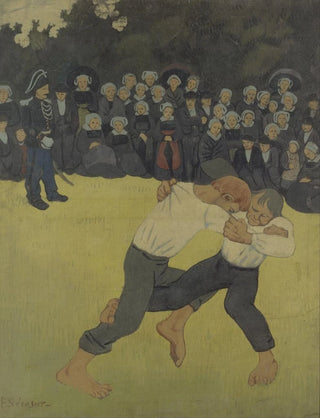Art print | Breton wrestling - Paul Sérusier


View from behind

Frame (optional)
In the vibrant world of modern art, "Lutte bretonne" by Paul Sérusier stands out as an iconic work, reflecting a period when color and form broke free from academic conventions. Created in 1888, this piece evokes the richness of Breton traditions through an innovative and bold lens. Sérusier, a member of the Nabi movement, demonstrates here his ability to transcend mere representation and immerse the viewer in a unique visual and emotional experience. Contemplating this artwork, one cannot help but be transported to a world where the struggle and Breton culture intertwine, creating an atmosphere that is both dynamic and poetic.
Style and uniqueness of the work
"Lutte bretonne" is distinguished by its bold style and striking chromatic choices. Influenced by the color theories of his time, Sérusier uses vivid and contrasting hues to express the tension and energy of Breton wrestlers. The composition, although figurative, moves away from realistic details to favor a more symbolic approach, where each color seems to vibrate with intrinsic meaning. The stylized forms of the characters, almost geometric, emphasize movement and strength, while offering an almost spiritual vision of the struggle. This artwork embodies the very essence of the Nabi movement, where art becomes a means of personal and collective expression, resonating with the cultural roots of Brittany.
The artist and his influence
Paul Sérusier, a central figure of the Nabi movement, made his mark on his era with his innovative approach to painting. Trained under the guidance of Paul Gauguin, he developed a style that combines personal intuition with a collective vision of art. His commitment to color and the simplification of forms paved the way for many artists, influencing future generations. "Lutte bretonne" is not only an illustration of his talent but also a reflection of his desire to capture the spirit of his time while celebrating popular traditions. Exploring themes of struggle and Breton culture, Sérusier invites us to rediscover

Matte finish

View from behind

Frame (optional)
In the vibrant world of modern art, "Lutte bretonne" by Paul Sérusier stands out as an iconic work, reflecting a period when color and form broke free from academic conventions. Created in 1888, this piece evokes the richness of Breton traditions through an innovative and bold lens. Sérusier, a member of the Nabi movement, demonstrates here his ability to transcend mere representation and immerse the viewer in a unique visual and emotional experience. Contemplating this artwork, one cannot help but be transported to a world where the struggle and Breton culture intertwine, creating an atmosphere that is both dynamic and poetic.
Style and uniqueness of the work
"Lutte bretonne" is distinguished by its bold style and striking chromatic choices. Influenced by the color theories of his time, Sérusier uses vivid and contrasting hues to express the tension and energy of Breton wrestlers. The composition, although figurative, moves away from realistic details to favor a more symbolic approach, where each color seems to vibrate with intrinsic meaning. The stylized forms of the characters, almost geometric, emphasize movement and strength, while offering an almost spiritual vision of the struggle. This artwork embodies the very essence of the Nabi movement, where art becomes a means of personal and collective expression, resonating with the cultural roots of Brittany.
The artist and his influence
Paul Sérusier, a central figure of the Nabi movement, made his mark on his era with his innovative approach to painting. Trained under the guidance of Paul Gauguin, he developed a style that combines personal intuition with a collective vision of art. His commitment to color and the simplification of forms paved the way for many artists, influencing future generations. "Lutte bretonne" is not only an illustration of his talent but also a reflection of his desire to capture the spirit of his time while celebrating popular traditions. Exploring themes of struggle and Breton culture, Sérusier invites us to rediscover






